3D-Modelling of Charlemagne’s Summit Canal (Southern Germany)—Merging Remote Sensing and Geoarchaeological Subsurface Data
Abstract
1. Introduction
2. Materials and Methods
2.1. Study Area
2.2. Data Acquisition
2.2.1. LiDAR Digital Terrain Model
2.2.2. Pre-Modern Digital Terrain Model
2.2.3. Magnetic Survey
2.2.4. Vibra-Coring
2.2.5. Direct Push Sensing
2.2.6. Archaeological Excavations
2.3. Modelling Routine
3. Results
3.1. Canal Course
3.2. Cross-Section Reference Geometries
3.3. Application of Cross-Section Reference Geometries to Vibra-Coring and Additive Transects
3.4. 3D-Model
3.5. Volume Calculation
4. Discussion
4.1. 3D-Modelling Approach and Quality
4.2. The Scientific History of Fossa Carolina Volume Calculations
4.3. Where Has All the Material Gone?
5. Conclusions
Author Contributions
Funding
Acknowledgments
Conflicts of Interest
References
- McCormick, M. The Origin of the European Economy. Communications and Commerce A.D. 300–900; Cambridge University Press: Cambridge, UK, 2010. [Google Scholar]
- Squatriti, P. Digging Ditches in Early Medieval Europe. Past Present 2002, 176, 11–65. [Google Scholar] [CrossRef]
- Leitholdt, E.; Zielhofer, C.; Berg-Hobohm, S.; Schnabl, K.; Kopecky-Hermanns, B.; Bussmann, J.; Härtling, J.W.; Reicherter, K.; Unger, K. Fossa Carolina: The First Attempt to Bridge the Central European Watershed—A Review, New Findings, and Geoarchaeological Challenges. Geoarchaeology 2012, 27, 88–104. [Google Scholar] [CrossRef]
- Werther, L.; Kröger, L.; Kirchner, A.; Zielhofer, C.; Leitholdt, E.; Schneider, M.; Linzen, S.; Berg-Hobohm, S.; Ettel, P. Fossata Magna—A Canal Contribution to Harbour Construction in the 1st Millenium AD. In Harbours as Object of Interdisciplinary Research: Archaeology + History + Geosciences; Carnap-Bornheim, C.V., Daim, F., Ettel, P., Warnke, U., Eds.; Verl. des RGZM: Mainz, Germany, 2018; pp. 355–372. ISBN 9783884672839. [Google Scholar]
- Preiser-Kapeller, J.; Werther, L. Connecting Harbours: A Comparison of Traffic Networks across Ancient and Medieval Europe. In Harbours as Object of Interdisciplinary Research: Archaeology + History + Geosciences; Carnap-Bornheim, C.V., Daim, F., Ettel, P., Warnke, U., Eds.; Verl. des RGZM: Mainz, Germany, 2018; pp. 7–31. ISBN 9783884672839. [Google Scholar]
- Beck, F. Der Karlsgraben Eine Historische, Topographische und Kritische Abhandlung. Mit Beilagen; Verlag der Friedrich Kornschen Buchhandlung: Nürnberg, Germany, 1911. [Google Scholar]
- Berg-Hobohm, S. Archäologische Forschungsgeschichte der Fossa Carolina. In Großbaustelle 793: Das Kanalprojekt Karls des Großen zwischen Rhein und Donau; Ettel, P., Berg-Hobohm, S., Eds.; Verl. des Römisch-Germanischen Zentralmuseums: Mainz, Germany, 2014; pp. 1–4. ISBN 978-3-88467-232-7. [Google Scholar]
- Koch, R. Fossa Carolina—1200 Jahre Karlsgraben; Denkmalpflege Informationen: München, Germany, 1993. [Google Scholar]
- Koch, R. Neue Beobachtungen und Forschungen zum Karlsgraben. Jahrbuch des Historischen Vereins für Mittelfranken 1996, 97, 1–16. [Google Scholar]
- Birzer, F. Der Kanalbauversuch Karls des Großen. Geologische Blätter für Nordost-Bayern und Angrenzende Gebiete 1958, 8, 171–178. [Google Scholar]
- Bruno, F.; Bruno, S.; de Sensi, G.; Luchi, M.-L.; Mancuso, S.; Muzzupappa, M. From 3D reconstruction to virtual reality: A complete methodology for digital archaeological exhibition. J. Cult. Herit. 2010, 11, 42–49. [Google Scholar] [CrossRef]
- De Reu, J.; de Smedt, P.; Herremans, D.; van Meirvenne, M.; Laloo, P.; de Clercq, W. On introducing an image-based 3D reconstruction method in archaeological excavation practice. J. Archaeol. Sci. 2014, 41, 251–262. [Google Scholar] [CrossRef]
- Ducke, B.; Score, D.; Reeves, J. Multiview 3D reconstruction of the archaeological site at Weymouth from image series. Comput. Graph. 2011, 35, 375–382. [Google Scholar] [CrossRef]
- Richards-Rissetto, H. What can GIS + 3D mean for landscape archaeology? J. Archaeol. Sci. 2017, 84, 10–21. [Google Scholar] [CrossRef]
- Forte, M. Virtual Reality, Cyberarchaeoloogy, teleimmersive Archaeology. In 3D Recording and Modelling in Archaeology and Cultural Heritage: Theory and Best Practises; Remondino, F., Campana, S., Eds.; Archaeopress: Oxford, UK, 2014; pp. 113–127. [Google Scholar]
- Koutsoudis, A.; Arnaoutoglou, F.; Chamzas, C. On 3D reconstruction of the old city of Xanthi. A minimum budget approach to virtual touring based on photogrammetry. J. Cult. Herit. 2007, 8, 26–31. [Google Scholar] [CrossRef]
- Pickett, J.; Schreck, J.S.; Holod, R.; Rassamakin, Y.; Halenko, O.; Woodfin, W. Architectural energetics for tumuli construction: The case of the medieval Chungul Kurgan on the Eurasian steppe. J. Archaeol. Sci. 2016, 75, 101–114. [Google Scholar] [CrossRef]
- Lacquement, C.H. Recalculating mound volume at moundville. Southeast. Archaeol. 2010, 29, 341–354. [Google Scholar] [CrossRef]
- Sherwood, S.C.; Kidder, T.R. The DaVincis of dirt: Geoarchaeological perspectives on Native American mound building in the Mississippi River basin. J. Anthropol. Archaeol. 2011, 30, 69–87. [Google Scholar] [CrossRef]
- Zielhofer, C.; Wellbrock, K.; Al-Souliman, A.S.; von Grafenstein, M.; Schneider, B.; Fitzsimmons, K.; Stele, A.; Lauer, T.; Von Suchodoletz, H.; Grottker, M. Climate forcing and shifts in water management on the Northwest Arabian Peninsula (mid-Holocene Rasif wetlands, Saudi Arabia). Quat. Int. 2018, 473, 120–140. [Google Scholar] [CrossRef]
- Grammer, B.; Draganits, E.; Gretscher, M.; Muss, U. LiDAR-guided Archaeological Survey of a Mediterranean Landscape: Lessons from the Ancient Greek Polis of Kolophon (Ionia, Western Anatolia). Archaeol. Prospect. 2017, 54, 64. [Google Scholar] [CrossRef]
- Cowley, D.; Moriarty, C.; Geddes, G.; Brown, G.; Wade, T.; Nichol, C. UAVs in Context: Archaeological Airborne Recording in a National Body of Survey and Record. Drones 2018, 2, 2. [Google Scholar] [CrossRef]
- Andersen, N.H. The Sarup Enclosures. The Funnel Beaker Culture of the Sarup Site including Two Causewaysed Camps Compared to the Contemporary Settlements in the Area and other European Enclosures; Aarhus University Press: Aarhus, Denmark, 1997. [Google Scholar]
- De Smedt, P.; van Meirvenne, M.; Herremans, D.; de Reu, J.; Saey, T.; Meerschman, E.; Crombé, P.; de Clercq, W. The 3-D reconstruction of medieval wetland reclamation through electromagnetic induction survey. Sci. Rep. 2013, 3, 1517. [Google Scholar] [CrossRef]
- De Smedt, P.; van Meirvenne, M.; Meerschman, E.; Saey, T.; Bats, M.; Court-Picon, M.; de Reu, J.; Zwertvaegher, A.; Antrop, M.; Bourgeois, J.; et al. Reconstructing palaeochannel morphology with a mobile multicoil electromagnetic induction sensor. Geomorphology 2011, 130, 136–141. [Google Scholar] [CrossRef]
- Diamanti, N.G.; Tsokas, G.N.; Tsourlos, P.I.; Vafidis, A. Integrated interpretation of geophysical data in the archaeological site of Europos (northern Greece). Archaeol. Prospect. 2005, 12, 79–91. [Google Scholar] [CrossRef]
- Hausmann, J.; Zielhofer, C.; Werther, L.; Berg-Hobohm, S.; Dietrich, P.; Heymann, R.; Werban, U. Direct push sensing in wetland (geo)archaeology: High-resolution reconstruction of buried canal structures (Fossa Carolina, Germany). Quat. Int. 2017, 473, 21–36. [Google Scholar] [CrossRef]
- Hadler, H.; Vött, A.; Newig, J.; Emde, K.; Finkler, C.; Fischer, P.; Willershäuser, T. Geoarchaeological evidence of marshland destruction in the area of Rungholt, present-day Wadden Sea around Hallig Südfall (North Frisia, Germany), by the Grote Mandrenke in 1362 AD. Quat. Int. 2018, 473, 37–54. [Google Scholar] [CrossRef]
- Seeliger, M.; Pint, A.; Frenzel, P.; Weisenseel, P.; Erkul, E.; Wilken, D.; Wunderlich, T.; Başaran, S.; Bücherl, H.; Herbrecht, M. Using a Multi-Proxy Approach to Detect and Date a Buried part of the Hellenistic City Wall of Ainos (NW Turkey). Geosciences 2018, 8, 357. [Google Scholar] [CrossRef]
- Canti, M.; Huisman, D.J. Scientific advances in geoarchaeology during the last twenty years. J. Archaeol. Sci. 2015, 56, 96–108. [Google Scholar] [CrossRef]
- Beuzen-Waller, T.; Stock, F.; Kondo, Y. Geoarchaeology: A toolbox for revealing latent data in sedimentological and archaeological records. Quat. Int. 2018, 483, 1–4. [Google Scholar] [CrossRef]
- Zielhofer, C.; Leitholdt, E.; Werther, L.; Stele, A.; Bussmann, J.; Linzen, S.; Schneider, M.; Meyer, C.; Berg-Hobohm, S.; Ettel, P. Charlemagne’s summit canal: An early medieval hydro-engineering project for passing the Central European Watershed. PLoS ONE 2014, 9, e108194. [Google Scholar] [CrossRef] [PubMed]
- Werther, L.; Feiner, D. Der Karlsgraben im Fokus der Archäologie. In Großbaustelle 793: Das Kanalprojekt Karls des Großen Zwischen Rhein und Donau; Ettel, P., Berg-Hobohm, S., Eds.; Verl. des Römisch-Germanischen Zentralmuseums: Mainz, Germany, 2014; pp. 33–40. ISBN 978-3-88467-232-7. [Google Scholar]
- Schmidt, J.; Werther, L.; Zielhofer, C. Shaping pre-modern digital terrain models: The former topography at Charlemagne’s canal construction site. PLoS ONE 2018, 13, e0200167. [Google Scholar] [CrossRef] [PubMed]
- Zielhofer, C.; Rabbel, W.; Wunderlich, T.; Vött, A.; Berg, S. Integrated geophysical and (geo)archaeological explorations in wetlands. Quat. Int. 2018, 473, 1–2. [Google Scholar] [CrossRef]
- Werther, L.; Zielhofer, C.; Herzig, F.; Leitholdt, E.; Schneider, M.; Linzen, S.; Berg-Hobohm, S.; Ettel, P.; Kirchner, A.; Dunkel, S. Häfen verbinden. Neue Befunde zu Verlauf, wasserbaulichem Konzept und Verlandung des Karlsgrabens. In Häfen im 1. Millennium AD: Bauliche Konzepte, Herrschaftliche und Religiöse Einflüsse, 1st ed.; Schmidts, T., Vučetić, M.M., Eds.; Schnell & Steiner; Verl. des RGZM: Regensburg, Mainz, Germany, 2015; pp. 151–185. ISBN 978-3-7954-3039-9. [Google Scholar]
- Werther, L. Karlsgraben doch Schiffbar? Aktuelles aus der Landesarchäologie. Archäologie Deutschland 2017, 5, 41–42. [Google Scholar]
- Völlmer, J.; Zielhofer, C.; Hausmann, J.; Dietrich, P.; Werban, U.; Schmidt, J.; Werther, L.; Berg, S. Minimalinvasive Direct-push Erkundung in der Feuchtboden(geo)archäologie am Beispiel des Karlsgrabens (Fossa Carolina). Archäologisches Korrespondenzblatt 2018, 48, 577–593. [Google Scholar]
- Leitholdt, E.; Krüger, A.; Zielhofer, C. The medieval peat layer of the Fossa Carolina—Evidence for bridging the Central European Watershed or climate control? Z. Geomorphol. Suppl. Issues 2014, 58, 189–209. [Google Scholar] [CrossRef]
- Kirchner, A.; Zielhofer, C.; Werther, L.; Schneider, M.; Linzen, S.; Wilken, D.; Wunderlich, T.; Rabbel, W.; Meyer, C.; Schmidt, J.; et al. A multidisciplinary approach in wetland geoarchaeology: Survey of the missing southern canal connection of the Fossa Carolina (SW Germany). Quat. Int. 2018, 473, 3–20. [Google Scholar] [CrossRef]
- Schmidt-Kaler, H. Geologie und Landschaftsentwicklung im Rezat-Altmühl Bereich; Bau intern Special Issue; Lipp: München, Germany, 1993; pp. 8–10. [Google Scholar]
- Zielhofer, C.; Kirchner, A. Naturräumliche Gunstlage der Fossa Carolina. In Großbaustelle 793: Das Kanalprojekt Karls des Großen zwischen Rhein und Donau; Ettel, P., Berg-Hobohm, S., Eds.; Verl. des Römisch-Germanischen Zentralmuseums: Mainz, Germany, 2014; pp. 5–8. ISBN 978-3-88467-232-7. [Google Scholar]
- Bavarian State Department of Cultural Heritage BLfD.; Luftbildarchiv, Archivnummer: 7130_027, Filmnummer: 3840B, Bild 12, 19.02.1985, 1985. Available online: https://www.ldbv.bayern.de/vermessung/luftbilder/archiv.html (accessed on 13 May 2013).
- Bavarian Land Surveying Office. Geländemodell. 2018. Available online: https://www.ldbv.bayern.de/produkte/3dprodukte/gelaende.html (accessed on 12 April 2019).
- Bavarian Land Surveying Office. Airborne Laserscanning. 2018. Available online: https://www.ldbv.bayern.de/produkte/3dprodukte/laser.html (accessed on 12 April 2019).
- Linzen, S.; Schultze, V.; Chwala, A.; Schüler, T.; Schulz, M.; Stolz, R.; Meyer, H.-G. Quantum Detection Meets Archaeology—Magnetic Prospection with SQUIDs, Highly Sensitive and Fast. In New Technologies for Archaeology; Reindel, M., Wagner, G.A., Eds.; Springer: Berlin/Heidelberg, Germany, 2009; pp. 71–85. [Google Scholar]
- Schneider, M.; Stolz, R.; Linzen, S.; Schiffler, M.; Chwala, A.; Schulz, M.; Dunkel, S.; Meyer, H.-G. Inversion of geo-magnetic full-tensor gradiometer data. J. Appl. Geophys. 2013, 92, 57–67. [Google Scholar] [CrossRef]
- Linzen, S.; Schneider, M.; Berg-Hobohm, S.; Werther, L.; Ettel, P.; Zielhofer, C.; Schmidt, J.; Fassbinder, J.W.E.; Wilken, D.; Fediuk, A.; et al. From magnetic SQUID prospection to excavation—Investigations at Fossa Carolina, Germany. In Proceedings of the 12th International Conference of Archaeoloigcal Prospection, Bradford, UK, 12–16 September 2017; Jennings, B., Gaffney, C., Sparrow, T., Gaffney, S., Eds.; Archaeopress: Oxford, UK, 2017; pp. 144–145, ISBN 978 1 78491 677 0. [Google Scholar]
- Linzen, S.; Schneider, M. Der Karlsgraben im Fokus der Geophysik. In Großbaustelle 793: Das Kanalprojekt Karls des Großen zwischen Rhein und Donau; Ettel, P., Berg-Hobohm, S., Eds.; Verl. des Römisch-Germanischen Zentralmuseums: Mainz, Germany, 2014; pp. 29–32. ISBN 978-3-88467-232-7. [Google Scholar]
- Dietrich, P.; Leven, C. Direct Push-Technologies. In Groundwater Geophysics, 2nd ed.; Kirsch, R., Ed.; Springer: Berlin, Germany, 2009; pp. 347–366. [Google Scholar]
- Leven, C.; Weiß, H.; Vienken, T.; Dietrich, P. Direct-Push-Technologien—Effiziente Untersuchungsmethoden für die Untergrunderkundung. Grundwasser 2011, 16, 221–234. [Google Scholar] [CrossRef]
- Hausmann, J.; Dietrich, P.; Vienken, T.; Werban, U. Technique, analysis routines, and application of direct push-driven in situ color logging. Environ. Earth Sci. 2016, 75, 659. [Google Scholar] [CrossRef]
- Butler, J.J.; Healey, J.M.; Zheng, L.; McCall, G.W.; Schulmeister, M.K. Hydrostratigraphic Characterization of Unconsolidated Alluvial Deposits with Direct-Push Sensor Technology; Kansas Geological Survey Open-File report 99-40; University of Kansas Field Station: Lawrence, KS, USA, 1999. [Google Scholar]
- Schulmeister, M.K.; Butler, J.J.; Healey, J.M.; Zheng, L.; Wysocki, D.A.; McCall, G.W. Direct-Push Electrical Conductivity Logging for High-Resolution Hydrostratigraphic Characterization. Groundw. Monit. Remediat. 2003, 23, 52–62. [Google Scholar] [CrossRef]
- Davis, J.C.; Herzfeld, U.C. Computers in Geology. 25 Years of Progress; Oxford University Press: New York, NY, USA, 1993; ISBN 0195085930. [Google Scholar]
- Carey, C.; Howard, A.J.; Knight, D.; Corcoran, J.; Heathcote, J. Deposit Modelling and Archaeology; University of Brighton: Brighton, UK, 2018; ISBN 978-1-5272-2244-1. [Google Scholar]
- Earley-Spadoni, T. Spatial History, deep mapping and digital storytelling: Archaeology’s future imagined through an engagement with the Digital Humanities. J. Archaeol. Sci. 2017, 84, 95–102. [Google Scholar] [CrossRef]
- Chapman, H.; Adcock, J.; Gater, J. An approach to mapping buried prehistoric palaeosols of the Atlantic seaboard in Northwest Europe using GPR, geoarchaeology and GIS and the implications for heritage management. J. Archaeol. Sci. 2009, 36, 2308–2313. [Google Scholar] [CrossRef]
- McCoy, M.D. Geospatial Big Data and archaeology: Prospects and problems too great to ignore. J. Archaeol. Sci. 2017, 84, 74–94. [Google Scholar] [CrossRef]
- Hofmann, H.H. Kaiser Karls Kanalbau: “Wie Künig Carl der Grosse unterstünde die Donaw vnd den Rhein zusam̄enzugraben”, 2nd ed.; Thorbecke: Sigmaringen, Germany, 1976; ISBN 3-7995-4014-8. [Google Scholar]
- Berg-Hobohm, S.; Werther, L. Das rezente Erscheinungsbild des Karlsgrabens. In Großbaustelle 793: Das Kanalprojekt Karls des Großen Zwischen Rhein und Donau; Ettel, P., Berg-Hobohm, S., Eds.; Verl. des Römisch-Germanischen Zentralmuseums: Mainz, Germany, 2014; pp. 9–12. ISBN 978-3-88467-232-7. [Google Scholar]

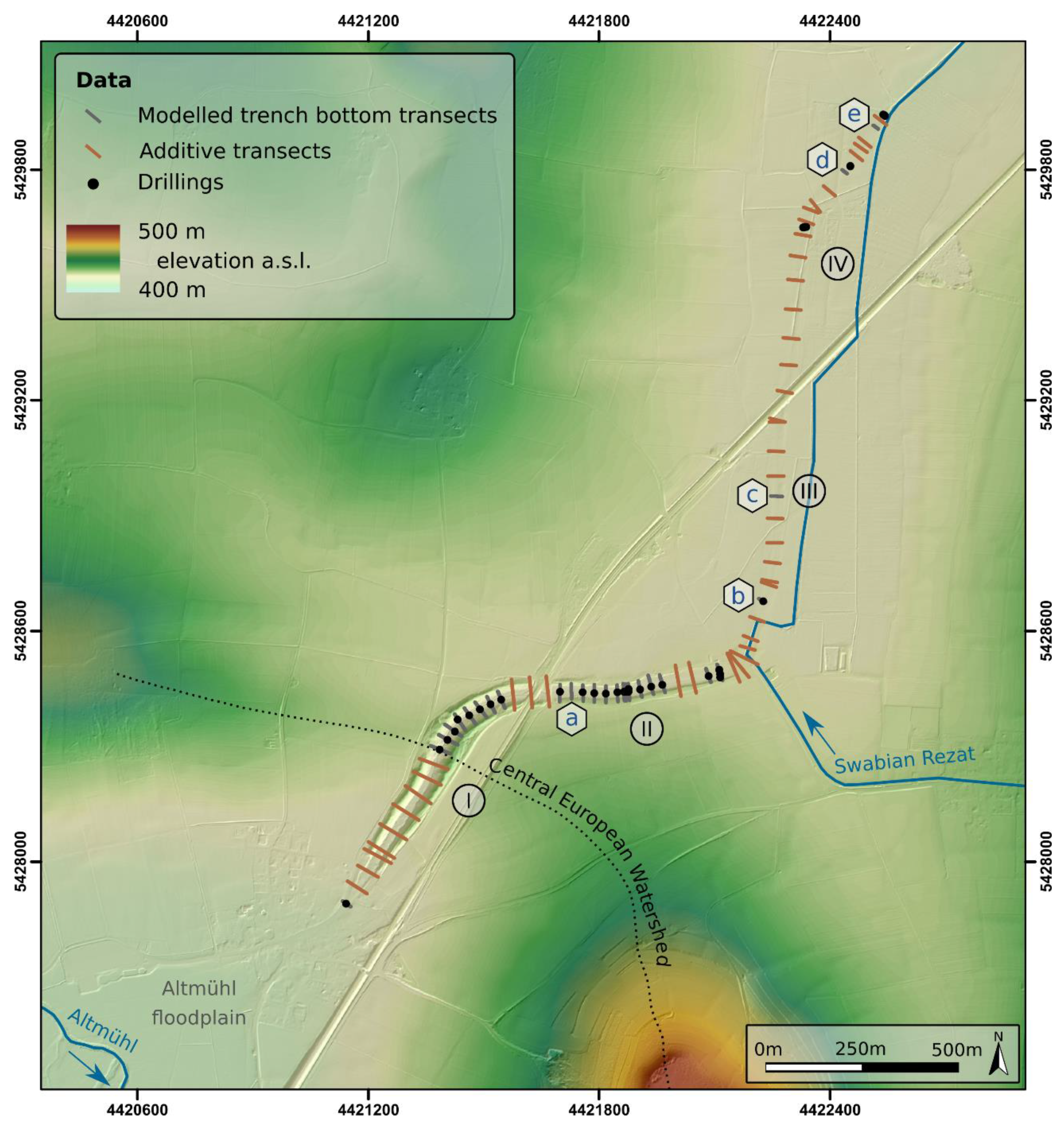
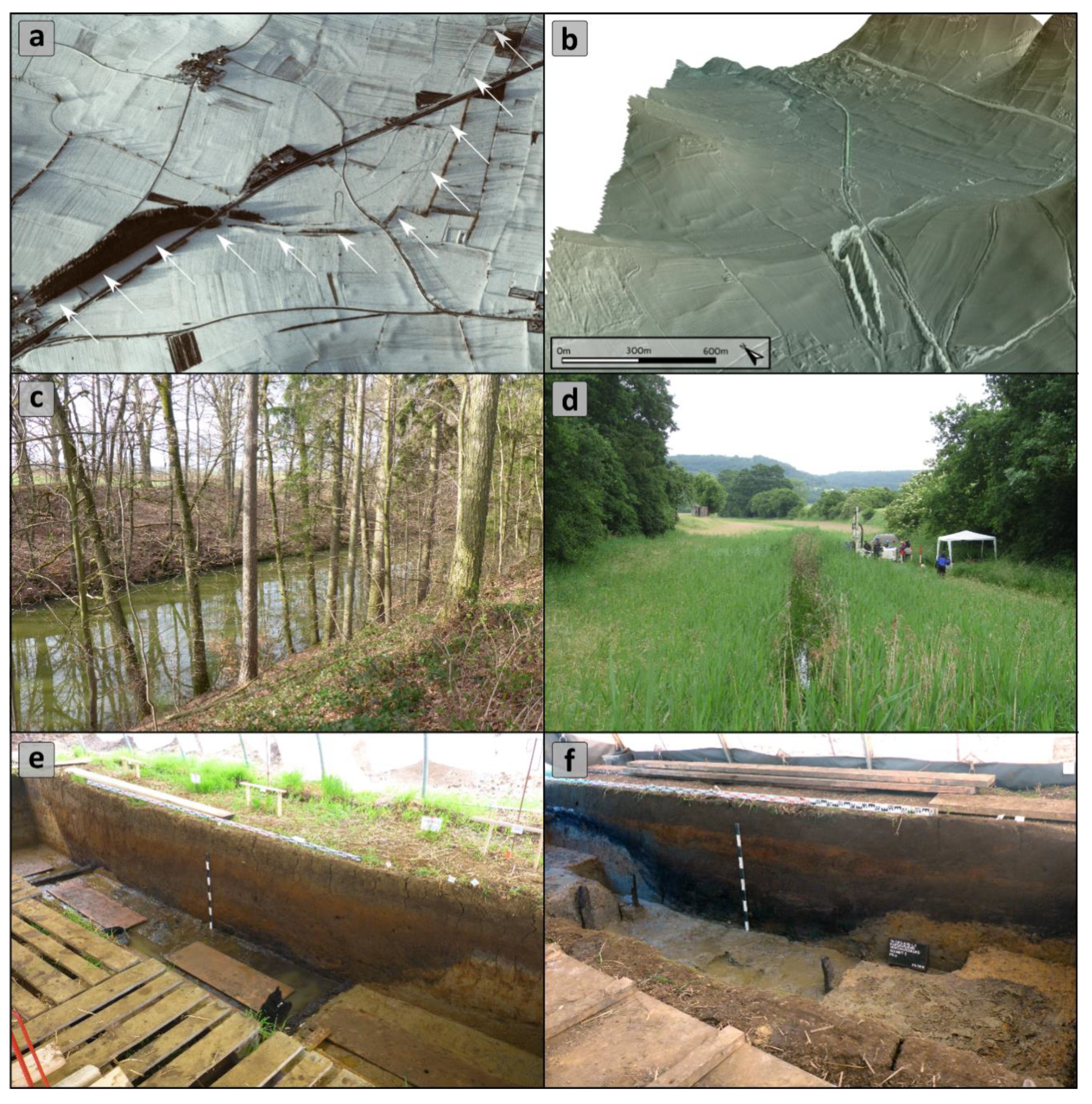
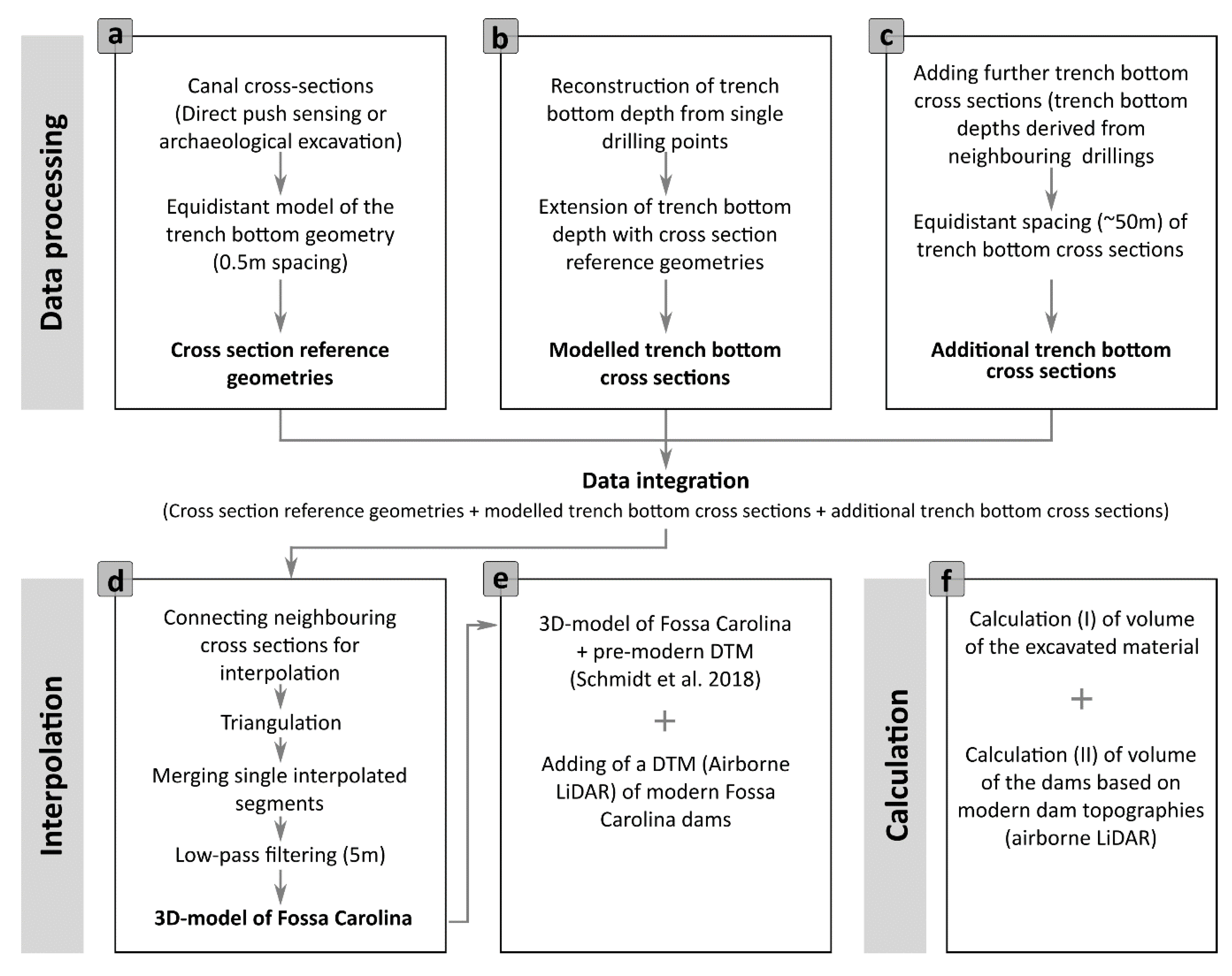
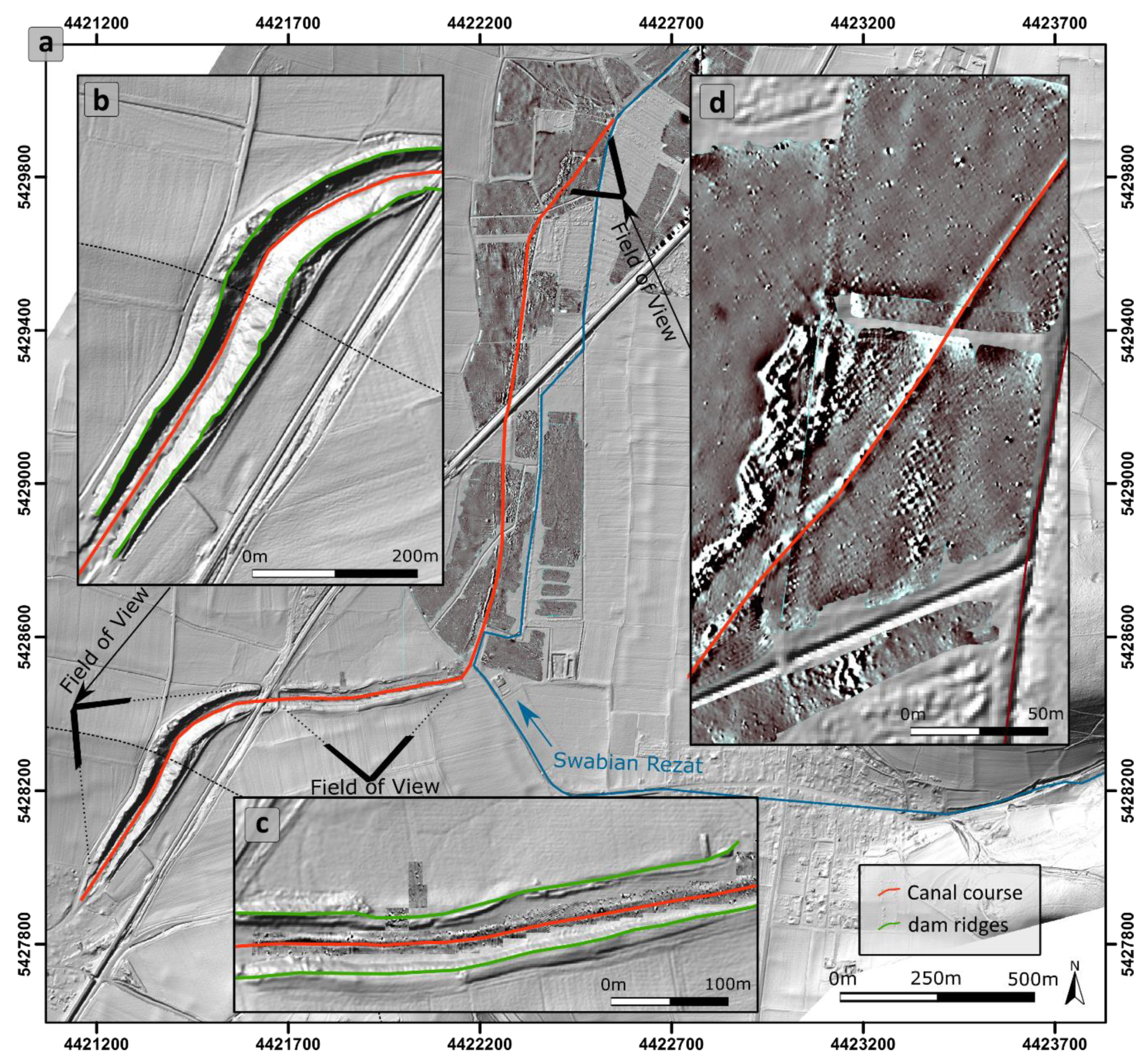
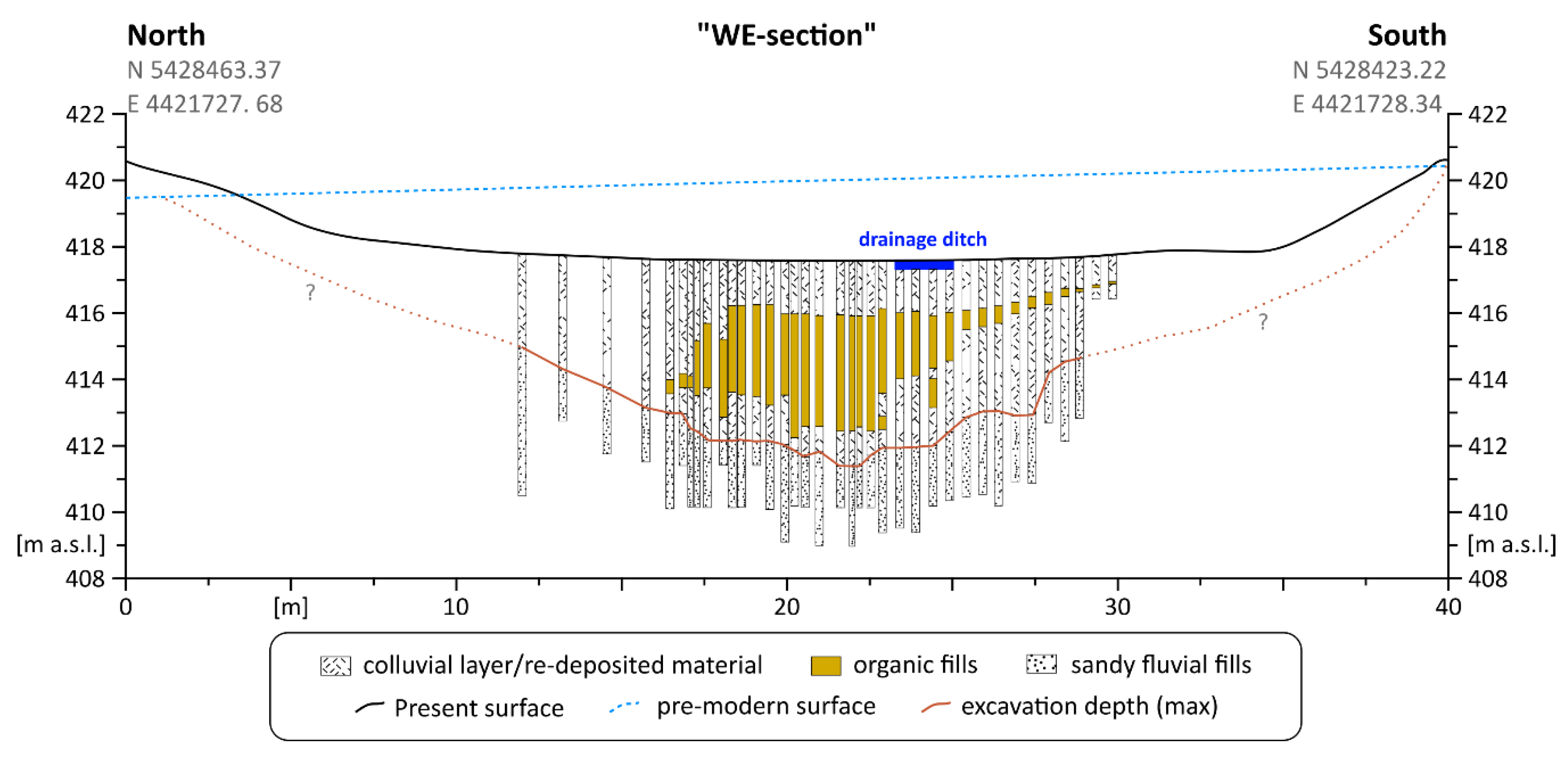
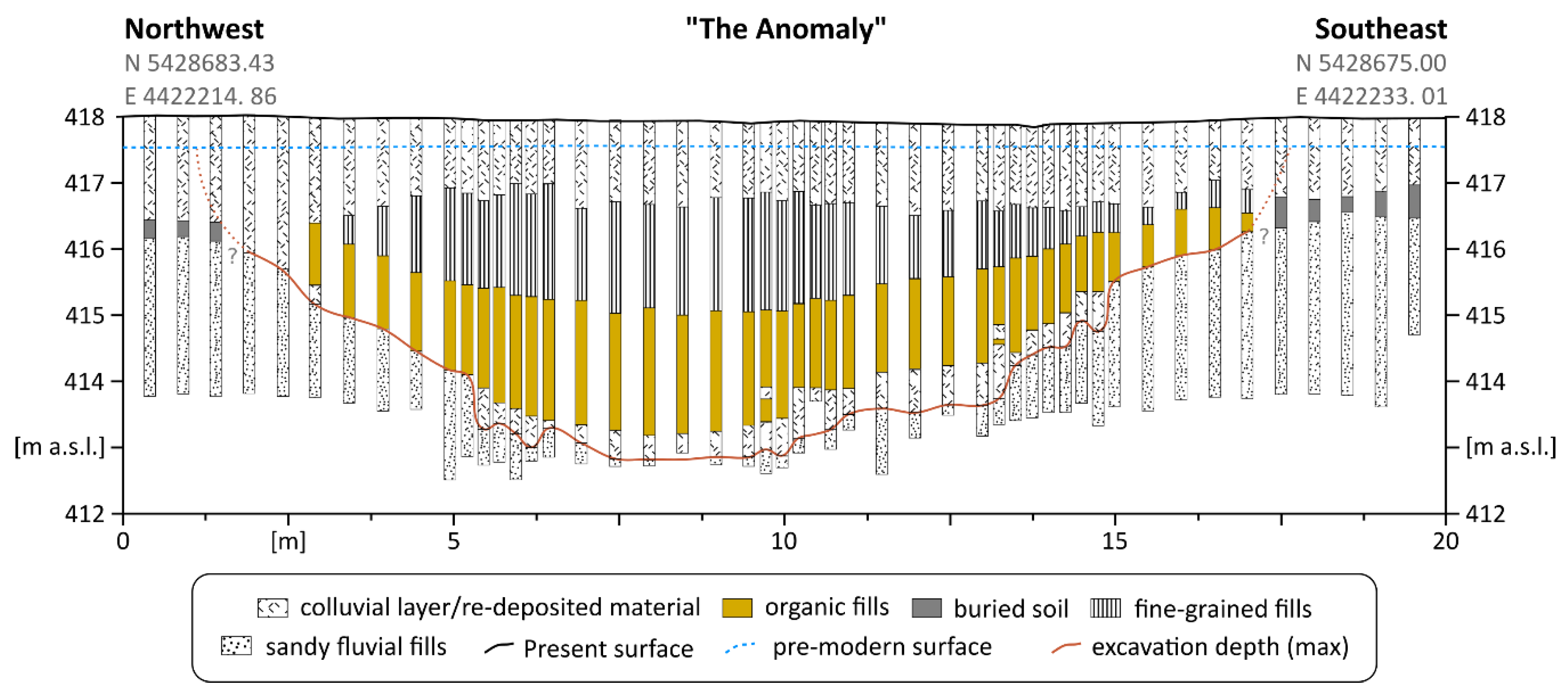
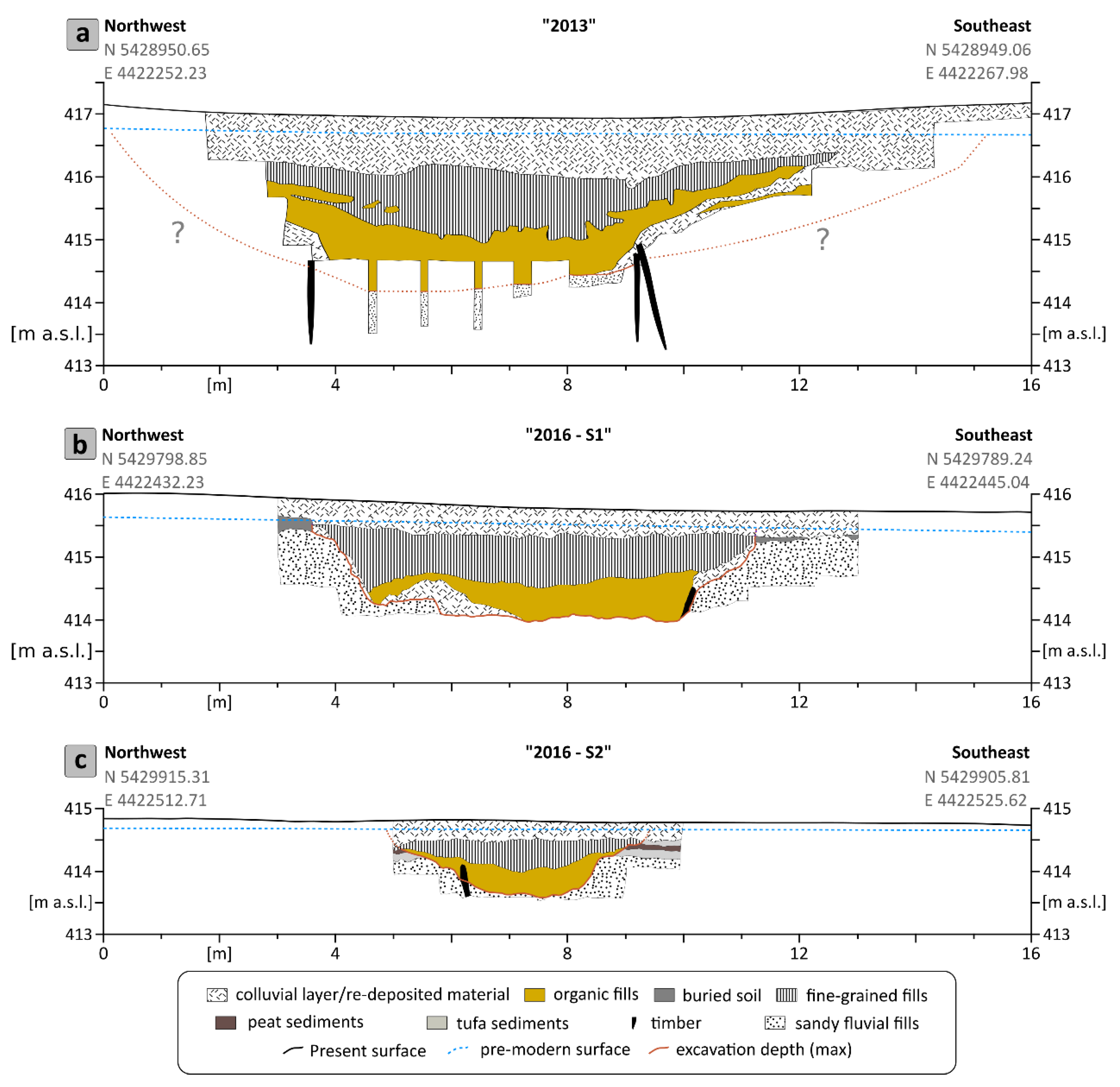
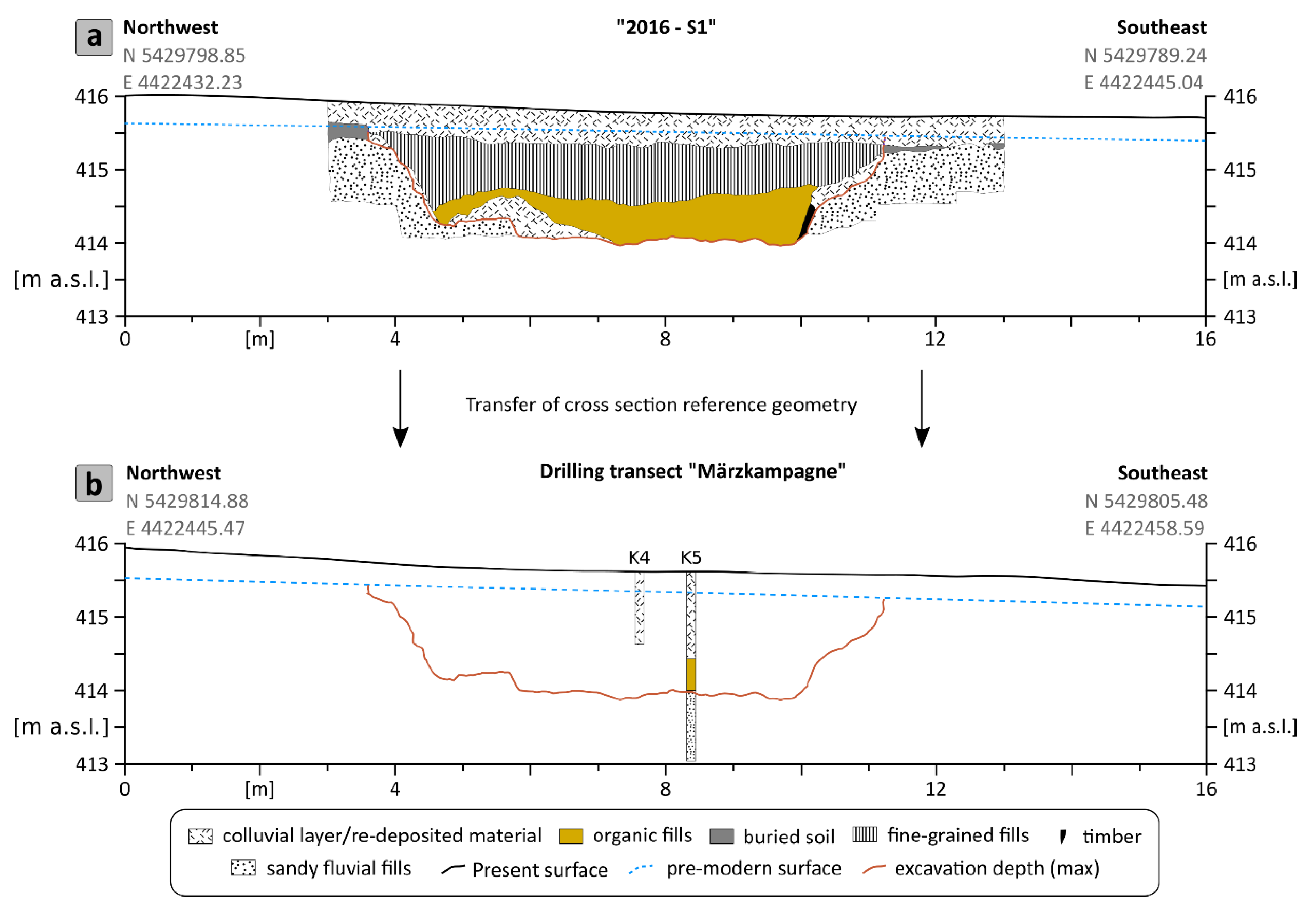
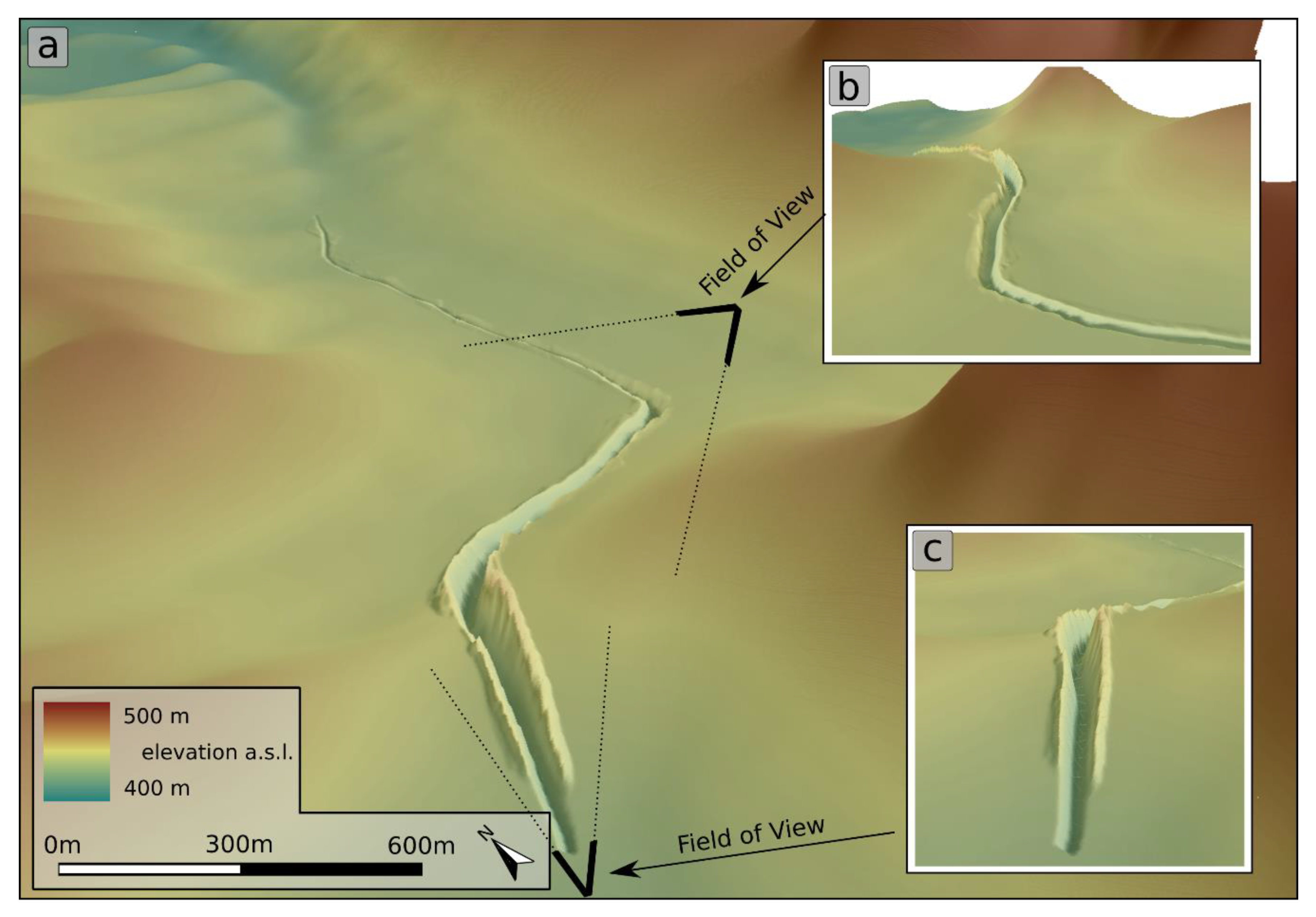
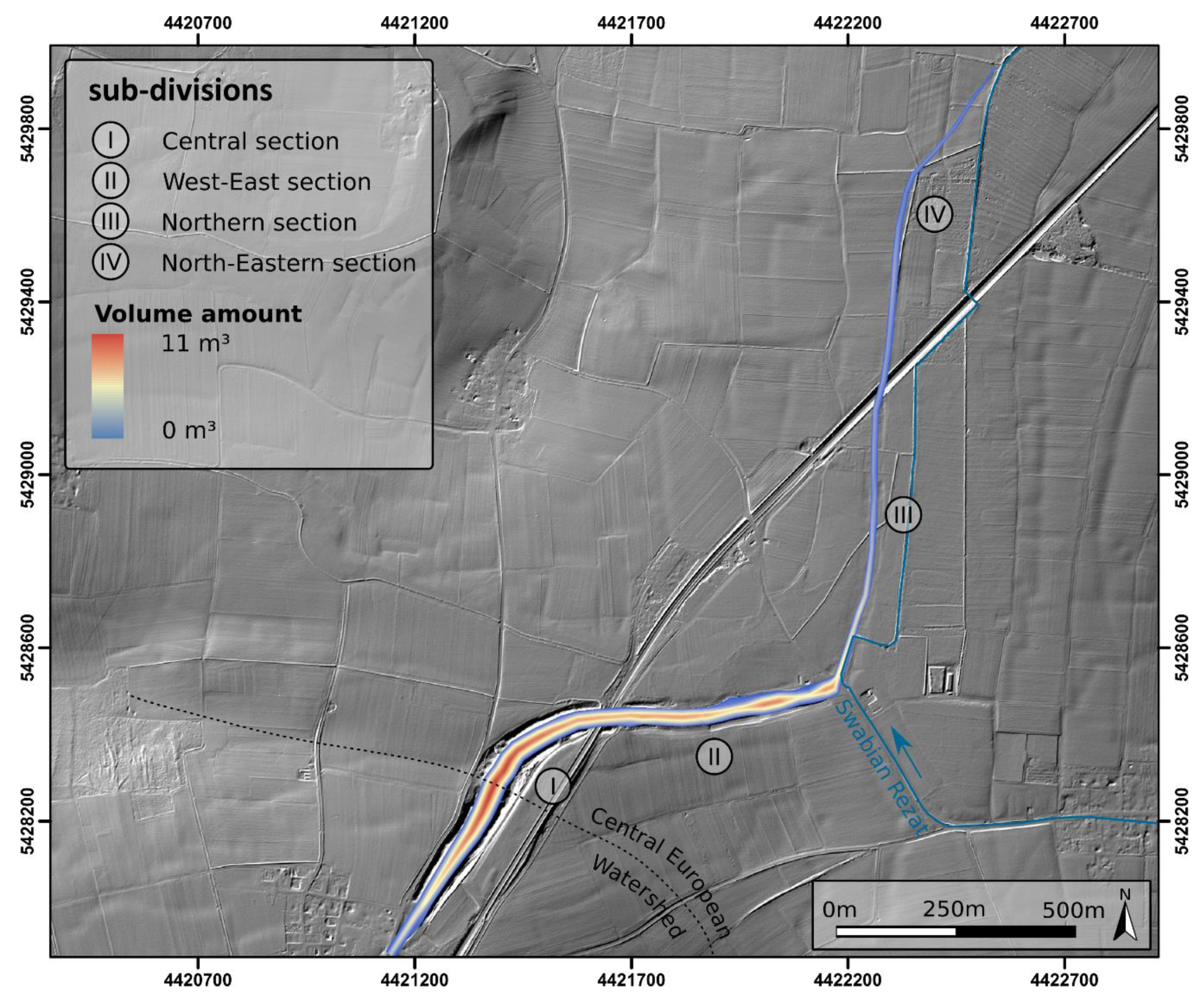
| Technique | Number | Name (Label in Figure 2) | References | Depth Accuracy | Lateral Distances | Scale | Resolution of Stratigraphy | Pace |
|---|---|---|---|---|---|---|---|---|
| Excavation | 3 trenches | “2013” (c) “2016–S1” (d) “2016–S2” (e) | Werther and Feiner 2014 [33]; Werther et al. 2015 [36]; Werther 2017 [37] | ++ | cm-scale | micro to small | +++ | - |
| Direct-push | 2 transects | “WE-Section” (a) “TheAnomaly” (b) | Völlmer et al. 2019 [38]; This study | ++ | 12.5 to 50 cm | micro to medium | ++ | ++ |
| Drilling | 26 transects | - | Leitholdt et al. 2012 [3]; Leitholdt et al. 2014 [39]; Zielhofer et al. 2014 [32]; Kirchner et al. 2018 [40]; This study | ○ | Up to 1 m | small to medium | + | + |
| Fossa Carolina Section | Length (m) | Cross-Section Reference Geometry | Type | Transferred to n Core Positions |
|---|---|---|---|---|
| Central Section | 803 | “WE cross-section” | direct push sensing | 10 |
| WE Section | 494 | “WE cross-section” | direct push sensing | 16 |
| Northern Section I (S) | 368 | “The Anomaly” | direct push sensing | 1 |
| Northern Section II (N) | 370 | “2013” | archaeological excavation | 6 |
| North-Eastern Section I (S) | 476 | “2013” | archaeological excavation | 0 |
| North-Eastern Section II (M) | 198 | “2016–S1” | archaeological excavation | 2 |
| North-Eastern Section III (N) | 120 | “2016–S2” | archaeological excavation | 4 |
| No. | Study | Volume | Object | Method | Comments |
|---|---|---|---|---|---|
| 1 | Birzer 1958 [10] | 80,000 m3 | canal trench | estimation/calculation | minimum; only Central and WE-Section |
| 3 | Birzer 1958 [10] | 450,000 m3 | canal trench | estimation/calculation | Assumed canal length of 4.5 km and constant trench bottom level |
| 6 | Hofmann 1976 [60] | 130,000 m3 | canal trench | calculation | Assumed canal length 1.4 km, width 30 m, depth 6 m |
| 5 | Koch 1993 [8] | several 100,000 m3 | canal trench | estimation | Assumed canal length 5–7 km |
| 2 | This study | 297,667 m3 | canal trench | calculation | Integrative approach |
| 7 | This study | 119,681 m3 | dams | calculation | Calculated based on present dams in comparison to pre-modern DTM |
| Section | Section Length | Length Proportion | Trench Volume | Trench Volume Proportion | Dam Volume | Ratio Dams/Trench |
|---|---|---|---|---|---|---|
| Total | 2829 m | 100% | 297,667 m3 | 100% | 119,681 m3 | 40% |
| Central Section | 803 m | 28% | 160,815 m3 | 54% | 83,826 m3 | 52% |
| WE Section | 494 m | 17% | 96,496 m3 | 32% | 20,449 m3 | 21% |
| Northern Section | 738 m | 27% | 26,267 m3 | 9% | 10,864 m3 | 41% |
| North-Eastern Section | 794 m | 27% | 14,088 m3 | 5% | 4,558 m3 | 32% |
© 2019 by the authors. Licensee MDPI, Basel, Switzerland. This article is an open access article distributed under the terms and conditions of the Creative Commons Attribution (CC BY) license (http://creativecommons.org/licenses/by/4.0/).
Share and Cite
Schmidt, J.; Rabiger-Völlmer, J.; Werther, L.; Werban, U.; Dietrich, P.; Berg, S.; Ettel, P.; Linzen, S.; Stele, A.; Schneider, B.; et al. 3D-Modelling of Charlemagne’s Summit Canal (Southern Germany)—Merging Remote Sensing and Geoarchaeological Subsurface Data. Remote Sens. 2019, 11, 1111. https://doi.org/10.3390/rs11091111
Schmidt J, Rabiger-Völlmer J, Werther L, Werban U, Dietrich P, Berg S, Ettel P, Linzen S, Stele A, Schneider B, et al. 3D-Modelling of Charlemagne’s Summit Canal (Southern Germany)—Merging Remote Sensing and Geoarchaeological Subsurface Data. Remote Sensing. 2019; 11(9):1111. https://doi.org/10.3390/rs11091111
Chicago/Turabian StyleSchmidt, Johannes, Johannes Rabiger-Völlmer, Lukas Werther, Ulrike Werban, Peter Dietrich, Stefanie Berg, Peter Ettel, Sven Linzen, Andreas Stele, Birgit Schneider, and et al. 2019. "3D-Modelling of Charlemagne’s Summit Canal (Southern Germany)—Merging Remote Sensing and Geoarchaeological Subsurface Data" Remote Sensing 11, no. 9: 1111. https://doi.org/10.3390/rs11091111
APA StyleSchmidt, J., Rabiger-Völlmer, J., Werther, L., Werban, U., Dietrich, P., Berg, S., Ettel, P., Linzen, S., Stele, A., Schneider, B., & Zielhofer, C. (2019). 3D-Modelling of Charlemagne’s Summit Canal (Southern Germany)—Merging Remote Sensing and Geoarchaeological Subsurface Data. Remote Sensing, 11(9), 1111. https://doi.org/10.3390/rs11091111






